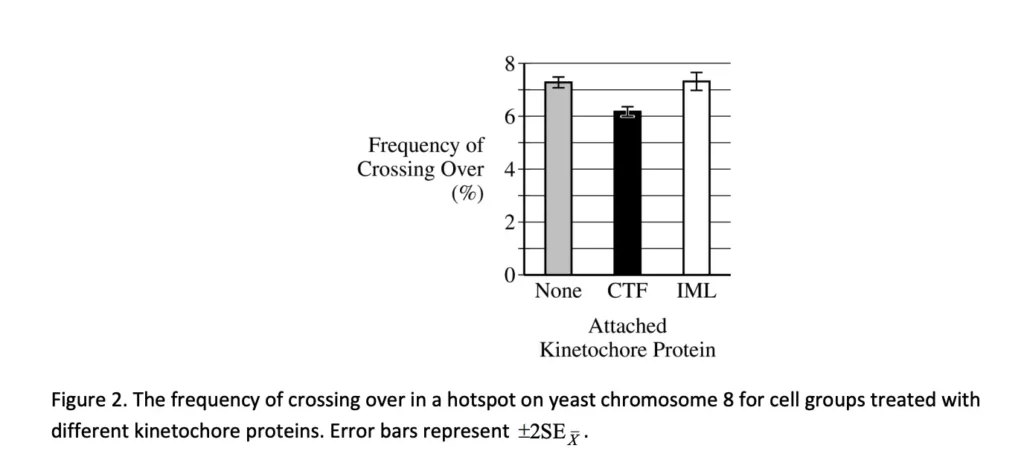If you’re preparing for the AP Biology Exam, the free response questions (FRQs) are an essential part of your success. These questions test your ability to apply the concepts you learned in your course, analyze data, and communicate scientific reasoning with structured, thoughtful responses.
Find out how FRQs are graded, the common question types, and proven strategies to help you write strong, high-scoring answers.
What’s on the AP Biology Exam?
The AP Bio Exam is 3 hours long with two sections, one for multiple-choice and quantitative analysis questions and a section with FRQs.[1]
| Sections | Time Limit | Number of Questions | Percentage of Exam Score |
| Section I | 1 hour 30 minutes | 60 multiple-choice questions | 50% |
| Section II | 1 hour 30 minutes | 6 free-response questions | 50% |
The multiple-choice and quantitative analysis questions are individual and sets of 4-5 covering visual representations, statistical tests, argumentation, and data description for biological concepts like cellular respiration, gene expression, cell structure and function, natural selection, and chemistry of life. There are 60 questions with 1 hour and 30 minutes allotted, comprising 50% of the exam score.
The FRQs consist of 2 long-form free response questions and 4 short-form free response questions covering scientific investigation, conceptual analysis, analysis of visual representation, and interpretation and evaluation of experimental results. This section comprises 50% of the exam score, with 1 hour and 30 minutes allotted.
How Are AP Bio FRQs Scored?
The first 2 questions are long form and worth 8-10 points each.[2] The 4 short-form questions are worth 4 points each. Unlike the multiple-choice questions, which are scored automatically, the free-response section is graded by qualified AP Bio teachers and college professors. You can get partial credit for incomplete responses.
While many AP exams have scoring rubrics that are similar across different free-response questions, the AP Bio FRQs have unique rubrics that evaluate different skills that are relevant to the question.
Here’s an example of an FRQ from the 2024 AP Bio Exam:[3]
“Question 1: Interpreting and Evaluating Experimental Results with Experimental Design – 9 points
Crossing over in meiosis is required for homologous chromosomes to properly align during metaphase and segregate during the first cell division.
Some regions of a chromosome called hotspots display a higher frequency of crossing over than other regions do. Crossing over is suppressed in chromosomal regions near the centromeres. The centromere region of a duplicated chromosome includes a collection of proteins that form a structure called the kinetochore. Scientists hypothesized that one or more of these kinetochore proteins are responsible for suppressing crossing over around the centromere.
To investigate their hypothesis, scientists modified chromosome 8 in yeast such that, in each cell, one chromosome from the pair of homologous chromosome 8s contained the gene encoding red fluorescent protein (RFP), while the other chromosome from the pair contained the gene encoding green fluorescent protein (GFP). Cells expressing RFP emit (give off) red light, and cells expressing GFP emit green light. Models of the modified chromosome 8, both before and after crossing over, are shown in Figure 1.

The scientists then investigated whether attaching individual kinetochore proteins to a specific DNA sequence present in a known crossing-over hotspot on chromosome 8 affected the frequency of crossing over at this location. In their first experiment, they examined three groups of yeast cells containing the modified chromosome 8. Group 1 contained no kinetochore proteins attached to the hotspot, group 2 contained the kinetochore protein CTF attached to the hotspot, and group 3 contained the kinetochore protein IML attached to the hotspot. For each group, the scientists determined the frequency of crossing over between the RFP and GFP genes. To determine the frequency, the scientists added the number of cells emitting both red and green light to the number of cells that emitted no light and divided by the total number of cells (Figure 2).”

The rubric breaks the response into 4 parts (a, b, c, and d). The total for all sections is 9 points, but each requirement is worth 1 point:[4]
| Part | Requirement | Point Value |
| (a) | Describe the function of S phase of interphase. | 1 point |
| (a) | Explain why some haploid cells formed after meiosis in this experiment will have only one fluorescent marker. | 1 point |
| Total for part (a) | 2 points | |
| (b) | Identify the control group for the scientists’ first experiment, shown in Figure 2. | 1 point |
| (b) | In a follow-up experiment, the scientists created a modified version of CTF in whichthe DNA-binding portion had been removed. They compared the frequency ofcrossing over in yeast cells in the presence and absence of unmodified CTF with thatin yeast cells in the presence and absence of the modified CTF protein (data notshown). In the follow-up experiment, justify why the scientists used a modified CTF protein that is unable to bind to DNA as a control. | 1 point |
| (b) | Identify the independent variable in the follow-up experiment. | 1 point |
| Total for part (b) | 3 points | |
| (c) | Based on Figure 2, describe the effect on the frequency of crossing over when CTF is attached to the chromosome 8 hotspot compared with the effect when IML is attached to the hotspot. | 1 point |
| Total for part (c) | 1 point | |
| (d) | Predict the effect on the number of copies of chromosome 8 likely to be present in the resulting daughter cells when CTF is attached to the hotspot. | 1 point |
| (d) | Provide reasoning to justify your prediction. | 1 point |
| (d) | Explain how the presence of hotspots could increase the likelihood that a population will survive in the presence of selective pressures. | 1 point |
| Total for part (d) | 3 points | |
| Total for Question 1 | 9 points |
The FRQs are 50% of the total AP Bio Exam score, which ranges from 1-5. According to the College Board, 16.8% of students scored a 5 on the 2024 exams.[5]
Test Prep Strategies for AP Bio FRQs
The concepts you learned in your AP Bio course give you a strong foundation for the exam, but you should still prepare. Here are some strategies for success with FRQs:
Read All the Questions
Read through all the FRQs to determine which will be easiest for you to answer. Start with the easiest questions, which ensures you have fully realized concepts for maximum scores on the concepts you understand well.
Show Your Work
Include every step you took to reach your solution on questions that involve calculations. Even if your answer is incorrect or incomplete, you may still get some credit. You’re allowed to bring a four-function, scientific, or graphing calculator, and you will be given an equations sheet to accompany the exam.[6]
Attempt Each Part of the Question
The FRQs are usually divided into parts with individual questions that form your entire response, as the example shows. Attempt to solve each part. Even if you don’t get credit for your answer for one part, you may get full or partial credit for the rest of the questions.
Stay Organized
Your answers should be organized according to the part, so make sure you label them (a), (b), (c), (d), etc. This not only keeps your thoughts organized but also gives you a guide to be sure you’ve answered each part fully.
Watch Your Units
Your answer should include consistent units. Do a quick proofread after finishing your response to make sure you have proper units for each number. You could lose points if you don’t express your answers in the wrong units or omit them completely.
Label Your Diagrams
Include labels for any graphs and diagrams, such as the x and y axes, best fit line, etc. Read the question carefully to ensure you understand what your visual representations should include. Missing these details could cost you points.
Look for Bold Verbs
There are certain words that are in bold to help you quickly ascertain what the question is asking. These are called “task verbs” and may include:[7]
- Calculate: Perform mathematical steps.
- Construct/Draw: Create a diagram, graph, representation, or model.
- Describe: Provide characteristics of a specified topic.
- Determine: Conclude after reasoning, observation, or calculations.
- Evaluate: Determine the significance of information or the accuracy of a claim.
- Explain: Provide information evaluating a relationship, process, pattern, position, or outcome using evidence.
- Identify: Provide information about a topic.
- Justify: Provide evidence to support or defend a claim.
- Make a claim: Assert something based on evidence or understanding.
- Predict: Predict the cause and effect of changes or disruptions in a relationship, pattern, or system.
- Represent: Use graphs, symbols, words, illustrations, or tables to describe biological concepts.
- State: Provide a hypothesis to support or defend a claim for a testable question.
- Support: Provide reasoning to explain how evidence supports a claim.
Keep It Concise
You won’t get more points for writing more. Stay as concise as possible while answering the question thoroughly and demonstrating your understanding of the scientific concepts. Avoid incomplete sentences, bullet points, and acronyms unless appropriate.
Pay Attention to Time
Working under the time constraint of the FRQs can add another layer of difficulty. Use the first 10 minutes for reading, 20 minutes for long-form responses, and 10 minutes for short-form responses. Avoid spending too much time on one question and cutting into your time for the others. If you’re struggling with one, shift your attention to another and circle back.
Use Practice Tests
The College Board provides sample questions, examples of previous high-scoring responses, study guides, and scoring guidelines to help you practice and assess your strengths and areas for improvement before the live exam.
Prepare for the AP Bio FRQs
If you’re intimidated by the AP Bio FRQs, consistent practice and review will help you build confidence for exam day. If you want strategic support, InGenius Prep offers subject-level tutoring for advanced subjects like AP Bio to help you maximize your score. Contact us today for your free consultation!
